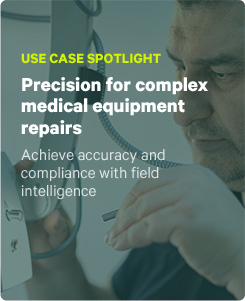AI is revolutionizing industries, and field service is no exception. It promises increased efficiency, smarter decision-making, and enhanced customer satisfaction. Yet, despite its transformative potential, AI adoption in field service is riddled with challenges. Organizations are encountering roadblock after roadblock as they make their move toward intelligent field service, research by Field Service Europe’s Artificial Intelligence Report has found.
1. Insufficient IT Infrastructure and Skilled Workforce
The Field Service AI Report reveals that 44% of field service leaders cite inadequate IT infrastructure and a lack of skilled workforce as the most significant barriers to AI adoption. Legacy systems, which can neither handle the demands of advanced AI applications or even offer any practicable integrations, remain prevalent in many organizations. Moreover, integrating AI requires technical expertise such as methodical prompt engineering – a scarcity in today’s workforce facing such a nascent technology.
To overcome this, organizations must make investments in modernizing their IT infrastructure and upskilling their employees alongside their AI budget. Training programs, certifications, and partnerships with AI vendors can help bridge the skills gap. Without these foundational changes, even the most sophisticated AI solutions will fail to deliver value.
2. Data Challenges: Quality and Integration
The saying “junk in, junk out” holds especially true for AI. Poor-quality data or insufficient data is a barrier for 19% of organizations surveyed by the report. For AI systems to make accurate predictions and provide actionable insights, they require consistent, clean, and comprehensive datasets.
System integration poses another challenge. Even with the rise in out-of-the-box integrations for many software applications, field service companies still operate with many siloed systems as a matter of course, leading to fragmented data across the organization. This lack of standardization and connectivity makes it difficult for AI to analyze and synthesize information effectively, resulting in insights that can have massive blind spots due to an incomplete picture of operational data.
3. High Costs
Adopting AI is not cheap. 25% of respondents in the report emphasized the high cost of AI implementation as a significant roadblock. Expenses include purchasing AI software, upgrading infrastructure, and training staff. For smaller organizations, these costs can be prohibitive, especially when returns on investment are not immediately apparent.
One way to mitigate costs is by starting small. Organizations can focus on high-impact, low-cost use cases, such as predictive maintenance or workforce scheduling. Demonstrating measurable ROI in these areas can build the case for further investment.
4. Challenges with AI Recommendations
The report reveals another critical issue: AI recommendations often fall short of expectations. 64% of respondents stated that AI recommendations fail to account for real-time feedback, while 61% found the recommendations inaccurate or of poor quality. This erodes trust in AI tools, making teams hesitant to adopt them fully.
Improving the accuracy and relevance of AI recommendations requires integrating real-time data and reinforcing feedback loops. For example, technicians can provide input on the practicality of AI-generated insights, which can then be used to refine algorithms. TrueContext CEO Alvaro Pombo points out, “Seamless user interaction and rich, up-to-the-moment data are critical to improving AI recommendations.”
5. Resistance to Change
Cultural resistance, while less of a barrier than in previous years, still persists. The report notes that only 14% of organizations struggle with adoption due to resistance, suggesting that most field service leaders recognize the potential of AI. However, hesitancy to change workflows, fear of job displacement, and lack of trust in technology remain hurdles for some teams.
To address this, organizations must emphasize the value AI adds to employees’ work. Clear communication, pilot projects, and involving staff in the implementation process can help alleviate concerns and foster a culture of innovation.
6. Lack of Defined Use Cases
A less obvious but equally important barrier is the lack of clearly defined use cases. According to the report, only 9% of respondents prioritize identifying correct use cases as part of their AI strategy. Without a clear understanding of how AI can be applied effectively, organizations risk investing in tools that do not align with their goals.
Field service leaders should start by identifying specific pain points and matching them with AI capabilities. For instance, predictive maintenance, which 50% of organizations plan to invest in, can significantly reduce downtime and maintenance costs.
7. Organizational Processes and Change Management
AI adoption often requires rethinking organizational processes. 38% percent of organizations are evolving their processes to make them compatible with AI, according to the report. This additionally involves integrating new tools and ensuring that data flows seamlessly across systems.
Change management is equally critical. Organizations need champions – leaders who advocate for AI, secure buy-in from stakeholders, and guide teams through the transition. These champions play a pivotal role in overcoming resistance and ensuring successful implementation.
Strategies to Overcome Barriers
While the barriers to AI adoption are substantial, they are not insurmountable. They are to be expected of any similarly disruptive technological revolution. Here are some strategies to address these challenges:
- Modernize Infrastructure: Upgrade legacy systems and invest in scalable, AI-ready platforms.
- Invest in Training: Equip employees with the skills to use AI tools effectively, such as prompt engineering.
- Focus on Data Quality: Standardize data formats and integrate systems to create a unified data source.
- Start Small: Pilot AI projects in specific areas to demonstrate ROI and build momentum.
- Engage Employees: Communicate the benefits of AI and involve teams in the implementation process.
AI has the potential to transform field service operations, but its adoption is not without challenges. From infrastructure limitations to cultural resistance, organizations face several hurdles that require thoughtful planning and investment. By addressing these barriers head-on and focusing on foundational changes, field service leaders can pave the way for AI to deliver its promised benefits—enhancing efficiency, reducing costs, and improving customer satisfaction.





